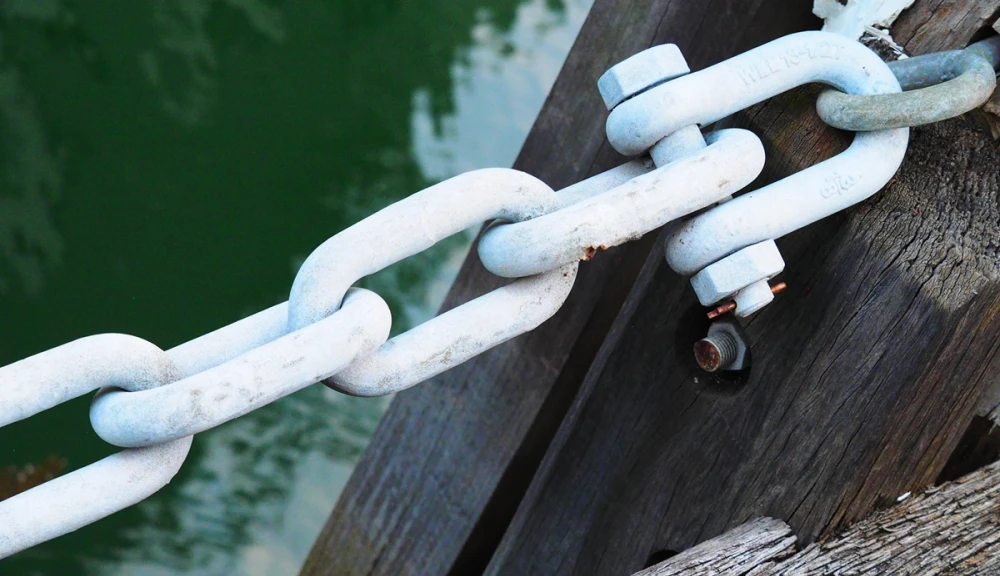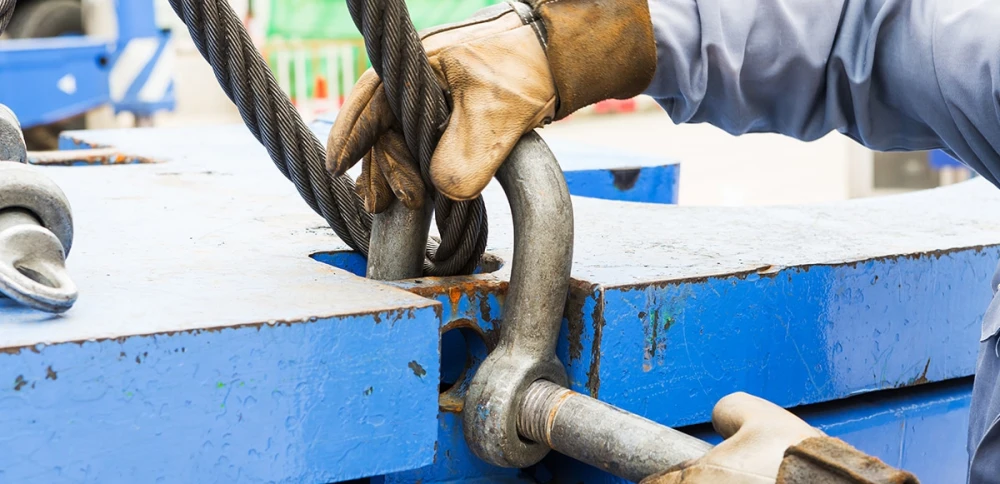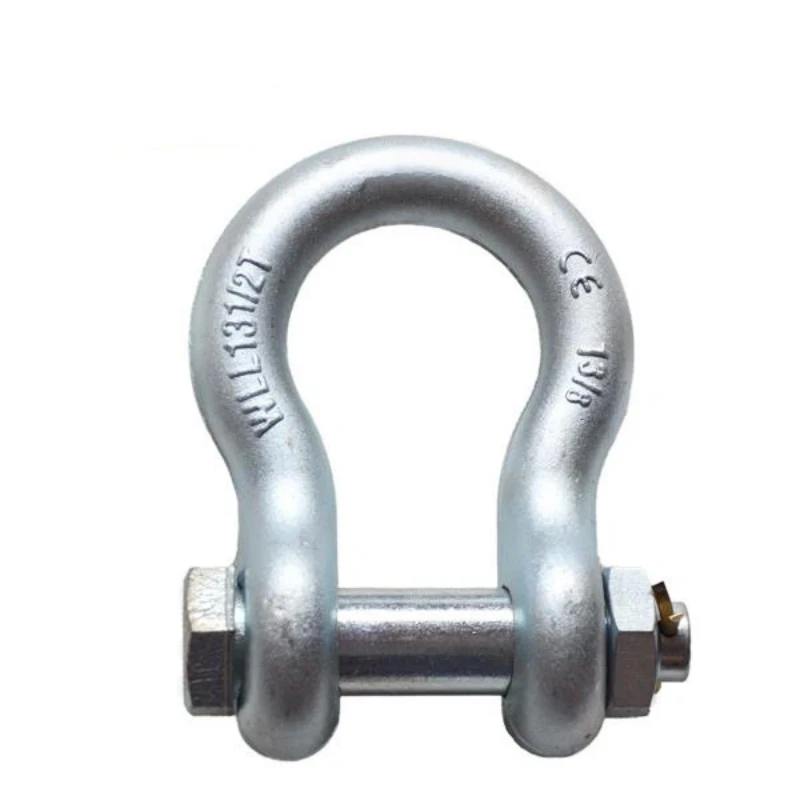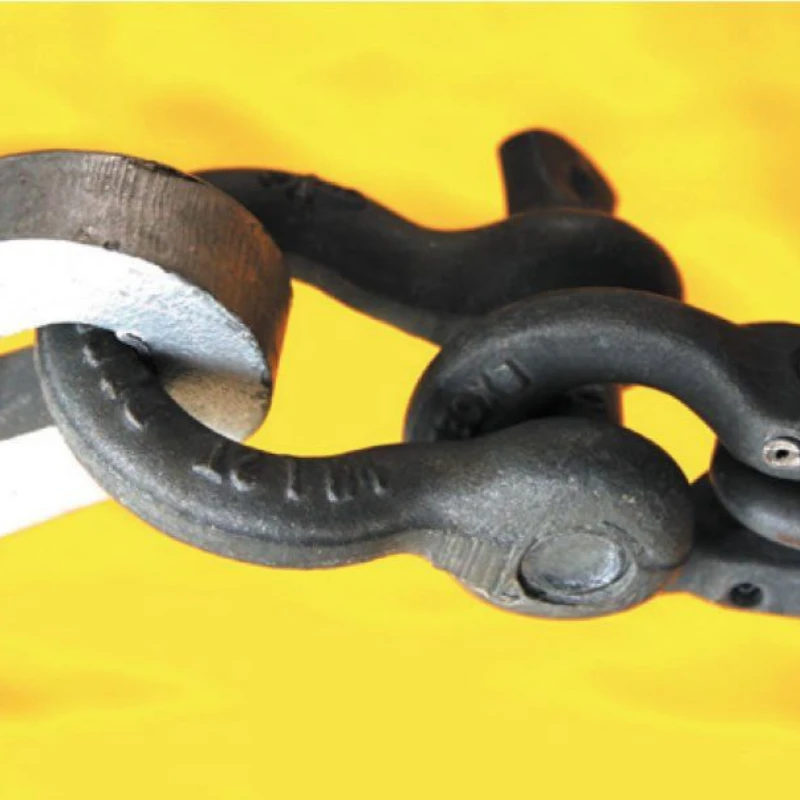A nautical shackle measures 90 feet (27.43 meters), which equals 15 fathoms. You rely on this standard length to connect chains, ropes, or equipment securely while at sea. The table below shows the historical measurement for clarity:
Measurement Type | Length |
|---|---|
Shackle | 15 fathoms |
Equivalent Feet | 90 feet |
Equivalent Meters | 27.432 meters |
You need to understand the correct length of shackles to keep marine operations safe and efficient.
Key Takeaways
A nautical shackle measures 90 feet (27.43 meters) or 15 fathoms. Knowing this standard length is crucial for safe marine operations.
Always check the working load limit (WLL) of a shackle before use. Exceeding this limit can lead to failure and accidents.
Regularly inspect shackles for wear, corrosion, or damage. Remove any shackle that shows signs of deterioration to ensure safety.
Use bow shackles for multi-directional loads and D shackles for straight pulls. Choosing the right type enhances safety and efficiency.
Measure shackles accurately using a caliper or ruler. Proper measurements ensure compatibility with chains and prevent accidents.
Nautical Shackle Length
Standard Length
You often see the term nautical shackle when working with anchor chains. This term refers to a specific measurement used worldwide. The standard length of anchor chain is 90 feet, which equals 27.43 meters. You can also express this as 15 fathoms.
The British Navy set this definition in 1949, and it remains the global standard today.
Tip: Remember that 1 fathom equals 6 feet (1.8288 meters). This makes it easy to convert between units when you need to calculate chain requirements.
Here is a quick comparison of common marine measurement units:
Measurement Unit | Length |
|---|---|
Shackle | 90 feet (27.43 meters) |
Fathom | 6 feet (1.8288 meters) |
Fathoms in a Shackle | 15 fathoms (90 feet) |
International standards help you ensure consistency and safety in marine operations. You will find these standards referenced in many technical documents and equipment manuals:
ASME B30.26
RR-C-271
EN 13889
AS 2741
These standards define the dimensions and performance requirements for shackles used in marine environments.
Why 90 Feet Matters?
You need to know the exact length of each shackle when you plan anchor chain requirements for large vessels. This knowledge helps you calculate how much chain you need for safe anchoring.
For example, a typical large vessel may require 605 meters of anchor chain, divided into two halves. Each half connects to 13 shackles, since one shackle measures 90 feet. This calculation ensures you have enough chain for secure anchoring in deep water.
Calculation Step | Description |
|---|---|
Shackle Length | 90 feet (1 shackle = 15 fathoms) |
Total Length | 605 meters divided into two halves |
Shackles Needed | 605/2 * 3.7878 / 90 = 12.73 shackles, round up to 13 |
Final Requirement | Each anchor connects to 13 shackles of chain |
You rely on the standard length to keep your vessel safe and stable. Accurate measurement prevents errors during anchoring and helps you follow international best practices. When you understand the role of the nautical shackle, you can make better decisions for your vessel’s safety and efficiency.
Shackle Dimensions
Key Measurements
You need to understand the main shackle dimensions before you select the right one for your marine application. Each shackle has several critical measurements that affect its strength and compatibility with other equipment. When you look at a shackle, pay close attention to these features:
Pin Diameter: This is the thickness of the pin that closes the shackle. The pin holds the load, so its size directly affects strength.
Body Diameter: This refers to the thickness of the shackle’s main body. A thicker body usually means higher load capacity.
Inside Width: This is the distance between the inner sides of the shackle. It determines what size chain or rope you can fit inside.
Inside Length: This is the space from the inside top of the shackle to the inside bottom. It affects how much room you have for connecting hardware.
Outside Width: This is the total width from one outer edge to the other. It helps you check if the shackle will fit in tight spaces.
Here is a table showing common shackle sizes used in marine applications:
Shackle Size | Pin Diameter | Body Diameter |
|---|---|---|
3/8″ | N/A | N/A |
1/2″ | N/A | N/A |
5/8″ | N/A | N/A |
3/4″ | N/A | N/A |
7/8″ | N/A | N/A |
1″ | N/A | N/A |
Note: Shackle dimensions can vary by manufacturer and application. Always check the specific measurements before making a selection.
You will find that larger shackles support more weight but require bigger pins. The size of the shackle is a key factor when you need to match it with your anchor chain or lifting gear.
Bow shackles have a wide, rounded body for multi-directional loads, while D shackles have a narrow shape for straight pulls. Wide-body shackles offer extra space for heavy lifting or multi-leg slings.
Measurement Methods
Measuring a shackle correctly ensures safety and compatibility in marine operations. You should always use a caliper or a ruler to check the pin diameter, inside width, inside length, and outside width. Follow these steps for accurate results:
Measure the existing shackle if you plan to replace it. This helps you match the size exactly.
If you are setting up a new system, choose a shackle size that prevents chafing and fits your chain or rope.
Select from a wide range of shackles based on the measurements you have taken.
You should also test the fit with your anchor chain, since shackle dimensions can differ between brands. The strength of your shackle should always exceed that of your anchor chain, especially if you use high-strength chains like G43 or higher.
High-quality shackles often have a safety factor of 4:1 to 6:1, which means they can handle loads much greater than their working load limit.
Evidence | Explanation |
|---|---|
Accurate measurement of a shackle ensures safe lifting and rigging operations. | Precise dimensions are essential for safety in marine environments, as they prevent accidents during lifting tasks. |
Shackles that do not meet the required specifications can result in accidents and inefficiencies during lifting operations. | Measurement accuracy directly affects safety and performance. |
Regular inspection and precise measurement help maintain the integrity of shackles. | Ongoing accuracy ensures shackles can handle loads safely over time. |
⚠️ Tip: Always check that your shackle meets or exceeds RR-C-271F specifications. Grade B shackles offer higher strength for demanding marine tasks.
You need to remember that side-loading can reduce the strength of a shackle. A 45-degree side load may lower the rated strength by 25%, while a 90-degree side load can cut it by half. Regular inspection and precise measurement help you avoid accidents and keep your equipment in top condition.
When you follow these steps for measuring a shackle, you help ensure the safety and efficiency of your marine operations. Accurate shackle dimensions protect your crew, your vessel, and your investment.
Types of Shackles
When you work with marine equipment, you will encounter several types of shackles. Each type serves a specific purpose and offers unique advantages for different tasks.
Anchor and Bow Shackles
You often use anchor and bow shackles for lifting and rigging. Both types can handle loads from multiple directions, but their shapes and uses differ. Anchor shackles have a larger, rounded “O” shape, while bow shackles feature a more defined bow area. The table below highlights their differences:
Shackle Type | Design Features | Applications |
|---|---|---|
Anchor Shackle | Larger, rounded ‘O’ shape; connects single/multiple sling legs | Widely used in lifting and rigging |
Bow Shackle | More defined bow area; designed for loads from various directions | Suitable for various rigging applications |
You can rely on both anchor and bow shackles for secure connections. For example, a Crosby G-209A shackle has a working load of 3,300 kg and a break load of 14,985 kg. This strength makes them ideal for heavy-duty marine tasks.
Chain and D Shackles

Chain shackles, also called D shackles, have a D-shaped design. You use them for straight-line tension applications. They work best when you connect chain to chain or other hardware without side loading. The table below shows their main features:
Feature | Chain Shackles (D-shackles) | D Shackles (Type D) |
|---|---|---|
Shape | D-shaped design | D-shaped design |
Pin Type | Threaded pin or removable pin | Removable pin secured by a cotter pin |
Material | Galvanized, stainless steel, or painted versions | Galvanized, stainless steel, or painted versions |
Load Capacity | High loads primarily in line | High loads primarily in line |
Compatibility | Compatible with stud-link chains | Connects the standard shackle of an anchor to the chain/rope |
Common Usage | Used in various marine applications | Commonly used in marine and rigging applications |
You should choose chain shackles when you need to lift, tow, or secure loads in a straight line. Avoid using them for multi-directional loads.
Specialty Shackles
Specialty shackles help you solve unique challenges in marine environments. You might need them for high-load applications or tricky rigging scenarios. Some examples include:
Synthetic sling shackles
Wide body shackles
Long reach shackles
Sheet pile shackles
Custom US anchor shackles for specific marine needs
Manufacturers like Crosby Group and Kee Safety offer custom solutions for heavy-duty projects. Specialty shackles can also include designs like the Blue wave rope bone dog, which lets you connect ropes quickly without knots, or the Wichard captive pin shackle, which reduces rope wear.
An adventure guide shared, “In the wild, the right specialty shackle can mean the difference between forgetting a safety measure and ensuring a secure ascent.”
You can trust specialty shackles to provide reliability and strength when standard gear falls short. By choosing the right type, you keep your nautical shackle system safe and efficient.
Shackle Safety

Working Load Limit
You must always check the working load limit before using any shackle. The working load limit tells you the maximum force a shackle can safely support. Manufacturers mark this value on shackles so you can easily find it.
Never exceed the working load limit, because doing so can cause the shackle to fail. You should select shackles based on the type of load and lifting angle. Always consult the manufacturer’s load charts to make sure you choose the right shackle for your job.
The working load limit is the most important safety factor for shackles.
Shackles must be certified and traceable to meet safety standards.
Regular inspections help you maintain the integrity of your shackles.
Industry standards, such as OSHA and ASME, require shackles to meet strict guidelines. Crosby shackles, for example, are forged for extra strength and have the working load limit clearly marked.
The safety factor for shackles usually ranges from 4:1 to 6:1. You should calculate the safe working load as one-fifth of the minimum breaking strength.
Parameter | Description |
|---|---|
Working Load Limit | The maximum force the shackle can support |
Safety Factor | Typically 4:1 to 6:1 |
Minimum Breaking Strength | Tensile strength × cross-sectional area |
Side-Loading
You need to avoid side-loading shackles whenever possible. Shackles are designed to handle loads in a straight line. If you apply force at an angle, you reduce the working load limit and risk damaging the shackle. The table below shows how side-loading affects the working load limit:
Angle of Side Load from Vertical | Adjusted Working Load Limit |
|---|---|
0° | 100% of the working load limit |
45° | 70% of the working load limit |
90° | 50% of the working load limit |
Over 90° | Not recommended |
⚠️ Tip: Never use shackles with side loads greater than 90°. Always check the angle and reduce the working load limit as needed.
Inspection and Materials

You should inspect shackles regularly to keep your equipment safe. Look for signs of wear, cracks, corrosion, or distortion. Remove any shackle that shows damage or has missing markings. The table below lists inspection criteria and when to remove a shackle:
Inspection Criteria | Remove Shackle? |
|---|---|
Illegible markings | Yes |
Heat damage | Yes |
Excessive corrosion | Yes |
Bent or twisted | Yes |
Nicks or gouges | Yes |
10% reduction in size | Yes |
Pin not fully engaged | Yes |
Thread damage | Yes |
Unauthorized welding | Yes |
Other visible damage | Yes |
You should inspect shackles yearly for normal service, monthly for severe service, and as recommended for special service. Store shackles away from moisture and chemicals to prevent damage.
Choosing stainless steel shackles helps you resist corrosion and extend the life of your equipment. Grade 316 stainless steel offers superior corrosion resistance for offshore and industrial use. Grade 304 stainless steel works well in chloride environments.
Stainless steel shackles provide excellent durability and corrosion resistance.
Regular inspection and proper storage keep shackles safe for marine operations.
Conclusion
You play a key role in marine safety when you understand shackle length and select the right type for your needs. Always check the Working Load Limit and inspect shackles before use. For best results, follow these tips:
Use bow shackles for multi-leg lifts and dee shackles for straight pulls.
Match shackle material to your environment.
Choose certified shackles and the correct pin type.
Watch sling angles and inspect for damage.
Stay alert and follow these steps to keep your crew and equipment safe.
FAQ
How do you identify the correct shackle size for your anchor chain?
You measure the chain link diameter and match it with the shackle’s pin diameter. Check manufacturer charts for compatibility. Always choose a shackle with a working load limit higher than your chain’s strength.
Can you use stainless steel shackles in saltwater environments?
Yes, you can use stainless steel shackles in saltwater. Grade 316 stainless steel resists corrosion best. Regularly rinse and inspect shackles to maintain safety and performance.
Tip: Choose marine-grade stainless steel for long-lasting durability in harsh conditions.
What does “working load limit” mean on a shackle?
The working load limit (WLL) shows the maximum safe load you can apply to a shackle. Manufacturers mark this value on the shackle body. Never exceed the WLL to avoid accidents.
How often should you inspect shackles on your vessel?
You should inspect shackles before each use and at least monthly. Look for cracks, corrosion, or bent parts. Remove any damaged shackles immediately.
Inspection Frequency | Recommended Action |
|---|---|
Before each use | Visual check |
Monthly | Detailed inspection |
After the overload event | Immediate replacement |


